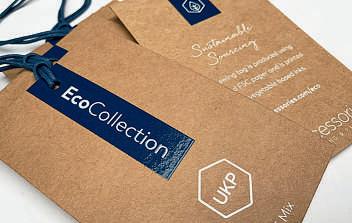
4 minute read
A sk Clive
IT NEED NOT COST THE EARTH
Organic cotton has a powerful story to tell, but you need to know what you are buying, says Clive Allcott
The branded clothing sector has seen an increasing demand for organic and certified clothing, especially with the current pandemic making us all think about the world we live in.
Many don’t realise that what we wear started life in the soil. Cotton is grown in a field, the fluffy fibre is picked and then spun into thread. Once woven into material it is light, breathable, easy to work with and easy to wear – this is why more than half the clothes sold in the UK are made from it.
There are various sustainable cottons available, but, if you want to be sure what you are buying or selling is grown in a truly sustainable way, go for certified organic cotton. Organic is the only workable practice which eliminates highly toxic substances from the environment and works for the long-term benefit of people and the planet.
Other fibres can be produced organically, such as hemp, flax (linen), jute, silk and wool, but cotton is the most commonly used.
So, what are the differences between organic cotton and conventional cotton?
The headline is that organic cotton is grown using methods and materials that have a low impact on the environment, but what does that really mean?
Organic production systems replenish and maintain soil fertility, reduce the use of toxic and persistent pesticides and fertilisers, and build biologically diverse agriculture.
Third-party certification organisations are then invited in to verify that organic producers use only methods and materials allowed in organic production. Along with no unnatural pesticides and fertilisers regulations prohibit the use of genetically engineered seed for organic farming.
How do I know if it’s organic?
Unlike food, textile products do not have to be certified in order to be described as organic which is confusing. A product claiming to be organic might only contain a small percentage of organic cotton or may be made of organic cotton but dyed using toxic chemicals which would never be allowed in certified organic products. However, the use of any organic cotton product is a positive step in the right direction.
In order to be sure a product really is organic from field to finished product, you need to look out for relevant accreditation, such as the Global Organic Textile Standard (GOTS) symbol as well as the OEKO-Tex symbol.
In reality we work in a difficult market where often the client wants the maximum quantity for their available budget. The price differential between certified organic and conventional products, can be considerable and does affect the choice of garment. If we however deliver the back story of sustainability and certified clothing to our clients along with a tangible way of promoting the reasoning and benefits (such as on a printed swing tag) to the recipient of the garment, then surely this can be a winner all round.


Happy Selling Clive, The Clothing Guru.
ORGANIC VS CONVENTIONAL COTTON
ORGANIC CONVENTIONAL
SEED PREPARATION Natural, untreated, genetically modified organism free seeds
SOIL PREPARATION Healthy soil through crop rotation. Retains moisture in soil from increased organic matter
WEED CONTROL
Healthy soil creates natural balance. Beneficial insects and trap crops used Aerial spraying of insecticides and pesticides. Nine of the most commonly used pesticides are known cancer-causing agents
HARVESTING
WEED CONTROL
Natural defoliation from freezing temperatures or through the use of water management Healthy soil creates natural balance. Beneficial insects and trap crops used Aerial spraying of insecticides and pesticides. Nine of the most commonly used pesticides are known cancer-causing agents
HARVESTING
Natural defoliation from freezing temperatures or through the use of water management
WHITENING
Safe peroxide is used Typically treated with fungicides or insecticides. Possible genetically modified organisms Synthetic fertilisers, loss of soil due to monocrop culture, intensive irrigation
Defoliation induced with toxic chemicals
Defoliation induced with toxic chemicals
Chlorine bleaching creates toxic by-products, which are released into the environment
FINISHING Soft scour in warm water with soda ash, for a pH of 7.5 to 8
DYEING
Low-impact fibre-reactive or natural dyes with low metal and sulphur content FAIR TRADE Social criteria in place to ensure safe, non-discriminatory environment healthy, non-abusive, with living wages
MARKETING
Positive story can be told to differentiate you from your competitors None. As awareness of organic advantage expands, increased potential for negative image
PRICE
Initial cost more expensive. Longterm advantages are priceless Hot water, synthetic surfactants, additional chemicals (sometimes formaldehyde)
High temperature containing heavy metals and sulphur
No social screening. Possible child or forced labour used. Facilities may be unsafe and unhealthy
Initially cheaper. Long-term impact on environment is devastating






